Harvesting honey is the sweetest task (see what I did there?) in all of beekeeping. It’s the tangible and delicious reward you obtain in exchange for caring for your honey bees.
Mining this precious commodity is like riding a bike. Once you get a feel for how the process is done, then it becomes easier during future harvests.
Now, there are some caveats when it comes to extracting honey that, especially, new beekeepers must be aware of, such as knowing when it’s appropriate to harvest honey, the tools needed for the job, how to filter the brood and much more.
My goal with this article is that by the time you’ve finished reading, you’ll feel confident and assured in your understanding of how to harvest your own honey.
Knowing Whether to Harvest Honey or Not is Extremely Important
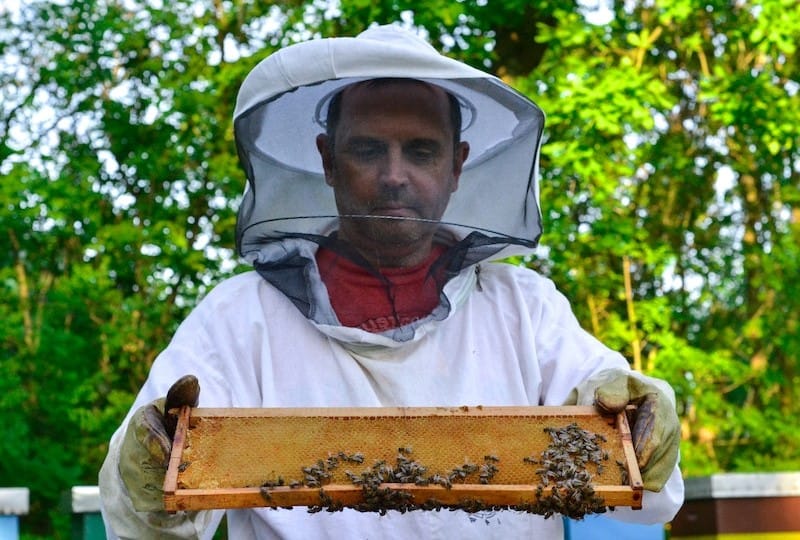
The honey bees don’t turn watery, sweet nectar into golden honey for us. They do it for themselves. We sometimes forget that.
We assume that they signed on the dotted line where we, humans, agreed that whatever honey they put in the brood box is theirs and what they deposit in the supers is ours.
According to our understanding, they would obviously fill up their stores first before they stocked up the ones for us. However, that’s not always the case.
Think about this…
Imagine if you had two piggy banks in your house. One you use to save money for a rainy day, and the other is for meeting your daily expenses. Ordinarily, you would focus on the daily expenses first and then deposit whatever was left in the rainy day fund.
Now imagine you had two piggy banks to save money simply. Again, there are no specifics. Just generally save money to meet your needs.
Since you have autonomy on how to spend your savings, you could choose to distribute your savings simultaneously without concentrating on either one, or you could choose to fill one up and then the other after — your choice.
The honey bees work in the same way and can sometimes fill up the super before stocking up on honey in the brood box. It’s been known to happen.
For that reason, before extracting honey, it’s a good idea to take a peek at the brood chamber and make sure that there is honey on the outer frames. If not, you’ll need to sacrifice some of the fresh honey for their well-being. It would be very tragic for you to enjoy a healthy harvest yet have your bees starve during the winter.
It’s also important to know what blooms in your area in the fall and whether there is anything likely to affect the season in the year. Honey is the best food you can provide for your bees. And, it’s less risky to leave them with their own supply rather than search for excess honey from other hives.
Some diseases can spread through honey, so most people advise beekeepers to use sugar syrup as an alternative food source. Honey from a diseased hive could easily wipe out your colony.
Your primary purpose as a beekeeper is to keep your bees healthy and thrive. Pure honey is a bonus gift that you may need to sacrifice once in a while.
How to Know When it is Time to Harvest Honey
Is your honey ready for harvest? Let’s find out…
Honey bees like to keep their home affairs to themselves.
They don’t make it easy for you to tell when the honey is ripe for harvest, probably because they don’t willingly give up their loot.
So how does a beekeeper, without the aid of x-ray vision or bee whispering technology, know when the honey is ready to harvest? Here are some of the ways:
Observation
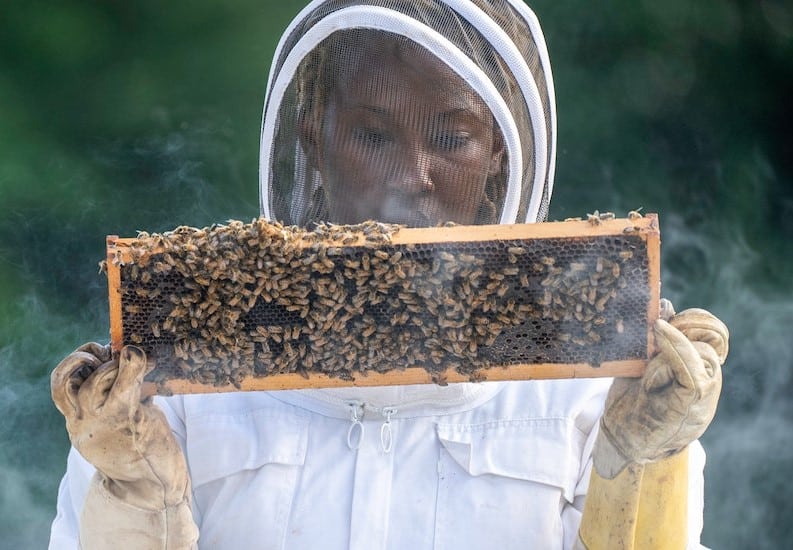
You’ll need to interrupt the ladies during nectar flows to monitor their progress. Every two to three weeks, check the supers to see if the bees have filled the comb with nectar.
When the nectar has been cured to the moisture level of 18%, that’s when we start to call the product honey. At that point, the bees cap it. So, as you pull out each frame, check to see if the honey has been capped with wax cappings.
Uncapped honey can still be harvested if it isn’t runny. You can check this by turning a full frame on its side and giving it a good, firm shake.
If you see little droplets with just one shake, then the honey isn’t ready. If not, it’s all up for grabs.
A Little Botany

What’s the main source of nectar in your area? Fruit trees, buckwheat, clover, alfalfa? Whatever it is, you need to understand the blossom pattern. When are the trees and flowers in your area in bloom? How long do they stay in bloom?
The best time for harvesting honey is at the end of the nectar flow season. That way, the bees are all stocked up, assuming the weather conditions are conducive. There would be plenty of liquid honey for them and extra honey for you.
The flowers that bloom in Spring will constitute the honey you harvest at the end of summer. So, as a responsible beekeeper, you will need to make sure that there are enough for your bees to get through the winter.
If you have another season of nectar in the fall, you can get away with raiding more honey. Then, there will be enough for your bee colony to collect as they settle down for winter.
If not, before collecting honey, check the brood boxes for honey just to ensure that the bees have enough to get through the cold season. Otherwise, they could starve.
Tools Needed to Harvest Honey
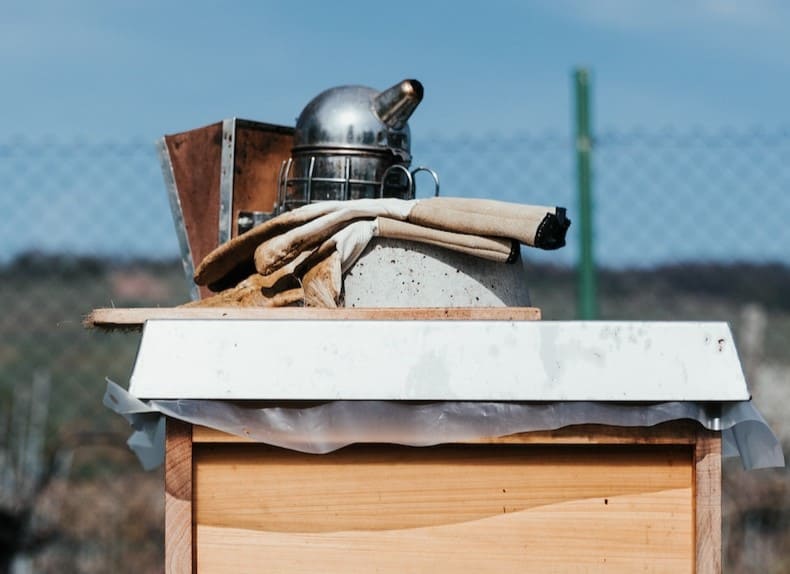
Protective gear – this could be a full suit and gloves or a jacket and veil, depending on your level of comfort with bees.
Smoker – This is just as important as the protective gear. You need something to break up the pheromone signals and get them interested in filling up on honey, making them a little easier to deal with.
Hive tool – never leave home without it. Bees bind every little crease and opening in the hive with propolis, and you’ll need a nifty little device like this to pry the frames with the honey loose.
Bee escape (optional) – A plastic board like this one here that can help to keep the bees away from the supers, which would greatly reduce your harvest time. The downside is that you’ll need to set this up in the hive a day before to benefit from it.
Bee brush – as you harvest, some of the bees will hang on to the honeycomb and you will need this to brush them off the capped honey and keep them in the hive. It’s gentle, helps to move the bees away from the surface you are working on, and keeps you from squashing bees unnecessarily.
Empty supers or a large bucket – Depending on your method of extraction, you could have a bucket to place the comb you cut out of the frame or a couple of supers you can place the frames once you brush off the bees. If you’re using a bee escape, you’ll be able to lift the supers off the hives, meaning you won’t need the additional storage containers.
How to Harvest Honey from a Beehive (Step by Step)
Here’s a simple guide to the honey harvesting process:
Step 1: Open the hive.
Before opening the hive, be completely suited up, especially if you are new to this. Have your smoker and other tools at close range or arm’s length.
Step 2: Smoke the bees.
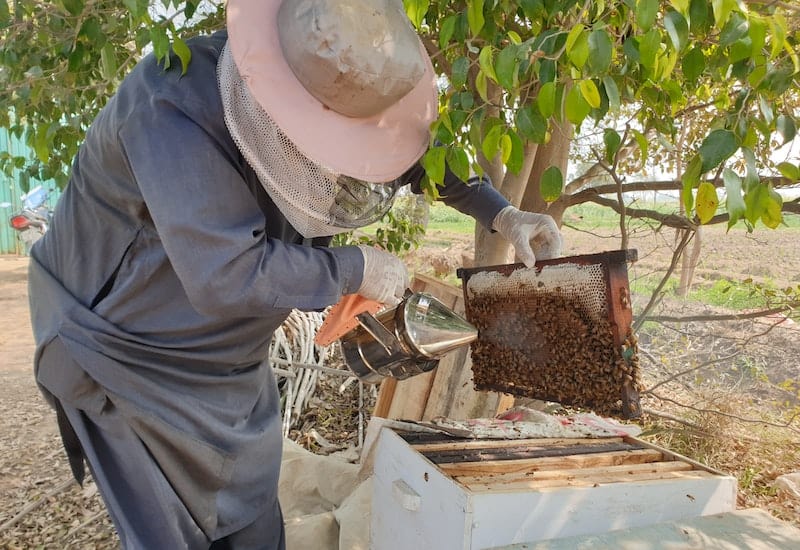
A few puffs to begin with, and then close the lid for a few seconds. This will make them direct their attention to drinking honey, and it’s hard to be so mad on a full stomach.
Every few minutes, you’ll need to direct one or two puffs of smoke their way to keep them even-tempered.
Step 3: Gather the frames.
Pull out the frames, one by one, that contain capped or cured honey.
Step 4: Cut the comb.

Some beekeepers do not have honey extractors and use manual methods to do the honey extraction process.
To do this, cut out the honeycomb into a bucket, leaving a strip that is about a quarter of an inch thick. It will allow the bees to rebuild the comb.
Use an uncapping knife to do this. Some beekeepers use a heated knife to cut the comb cleanly.
Step 5: Replace the Comb
Put the comb back on the hive box, one by one.
Step 6: Escape with your loot.
Commercial beekeepers prefer using a honey extractor in harvesting honey. If you use a honey extractor, you’ll skip Step 4 and either place the frame with the honeycomb in the empty frameless super or carry the super directly from the hive if you have used a bee escape board.
Honey extractors separate honey from honeycombs through the generation of a centrifugal force. Honey extractors extract honey quickly from your frame baskets while spinning into your extractor’s drum.
Once you have extracted the honey, you will take back the now-empty frames and put them back in the hive. This should be done within five days to reduce the risk of introducing pests such as the wax moth to your unguarded honeycomb.
How to Harvest and Extract Honey Without a Honey Extractor
The main tool you need for this method is patience. Gravity is the one in control here. Once you have the comb you want to harvest, simply crush it with a knife or any other sharp tool and keep at it like you’re mashing potatoes. When you’ve gotten rid of all the big clumps, put the honey through a colander or any container with small holes and then wait.
If you have a large amount, get a bucket like this and make a few holes at the bottom and use that as your strainer. Cover it all up and go about your business for the rest of the day. Gravity will do the rest. It’s that simple.
How to Filter Brood Out of the Honey Harvest
Straining
If at all you wind up with some brood larva in the comb you are harvesting, straining the honey with something like this should take care of all the foreign bodies and other debris. If they escape that, you can allow the honey to settle overnight. Since honey is dense, it settles at the bottom, and all the wax debris and bee parts float to the top, where you can scrape them off. All in all, this shouldn’t be a very big worry.
Now, prevention is better than a cure, as they say. So, it would be better if there was no brood to filter from the honey.
How then does one keep the queen from demonstrating her egg-laying expertise in the frames you want to harvest honey from?
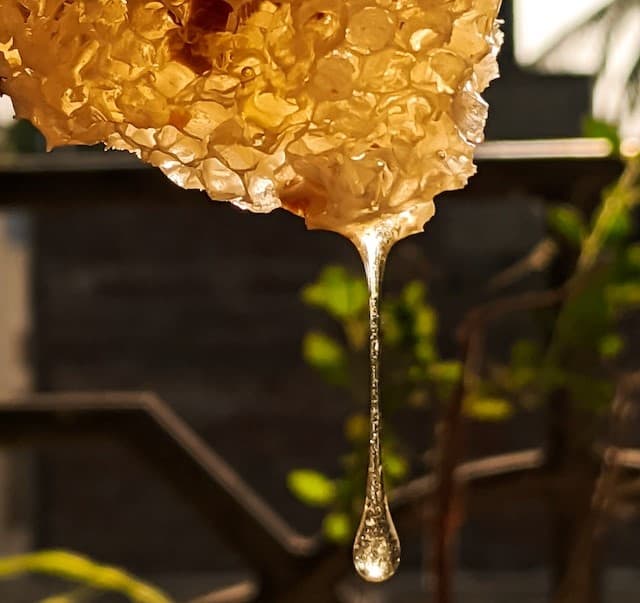
Queen Excluder
One way is using a queen excluder. It serves the same purpose as a bouncer in the VIP section of a very exclusive club. The only difference is that, in the hive, this exclusive room admits almost everyone but the VIP.
The queen excluder is usually made of plastic and is comprised of bars that have little space between them. The idea is to let the worker bees through, but anything bigger, such as a queen or a drone, can’t quite fit. As a result, no brood in the honey super.
Warré Hive
Another way to keep them out is to use a Warré hive. With this wonderful design, the queen always lays in a newly drawn comb. Since new boxes are always added below the existing ones, her laying activities are focused on the lower boxes, and honey gets stored in the higher ones. It’s a very effective system.
If you don’t have a Warré hive, then you can arrange frames that contain honey in the center of the super above the brood. Since most of the brood is found in the center frames, the queen is unlikely to lay eggs in a comb that is above a honey belt, so to speak.
How Often to Harvest Honey
How often can you harvest honey? Well, it depends (this is an answer you will get to most of your beekeeper questions, so get used to it).
How long are your winters? What variety of blooms do you enjoy in spring? Does the temperature warm up in time for the bees to forage, or is your area prone to abrupt cold snaps?
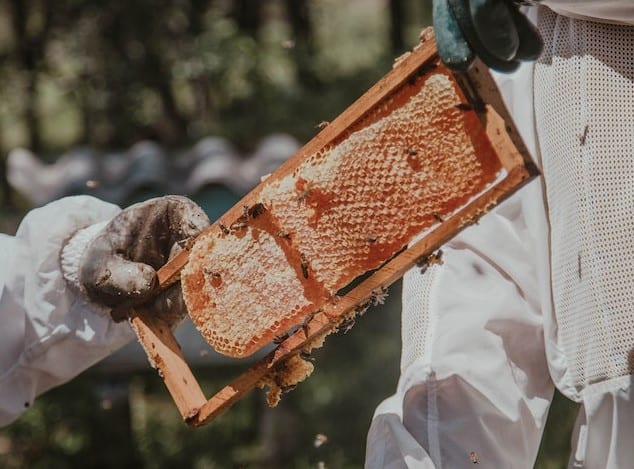
There are several variables to consider, but in general, you will harvest once, maybe twice a year, if you’re lucky.
The first year for beginner beekeepers is not likely to yield enough honey for the beekeeper, so it would be prudent to scrap it from your plans. Let it be a rare happy surprise if you are one of the lucky few to get a first crop in the first year.
Subsequent harvests will depend on prevailing weather conditions and available nectar sources, which, with climate change, are becoming less predictable these days.
The first year will teach you quite a lot about the foraging habits of your honeybees and the nectar sources in your area. That will help you figure out when you are likely to get a honey crop and how many to expect realistically.
The Truth About Harvesting Honey: It is a Matter of Patience
No Ponzi scheme here. It’s not an exact science because there are so many variables to consider in the production of honey. Every plant hardiness zone has a different bloom season for different plants, meaning that the bee calendar varies from place to place, even from year to year. It may sound daunting, but it gets a little easier to plan your activities with experience.
That said, the general consensus is that you shouldn’t expect to harvest honey in your first year of beekeeping. You could, but it’s rare.
Instead, your concern should be learning as much as you can about the behavior of your little tenants and keeping them healthy. Once they’ve made it through the winter, then you may start to think about the next year’s harvest.
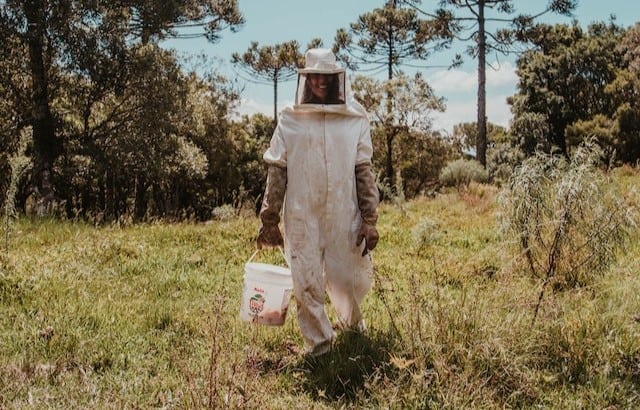
Thank Your Honey Bees
Harvesting honey is actually quite simple. As you gain more experience, you’ll be able to move quicker without injuring the bees.
In the beginning, as with everything else about beekeeping, it can seem intimidating, but you’ll get the hang of it.
If you want a shortcut, you could get yourself a flow-hive, although that is a separate discussion with its own list of pros and cons.
A good harvest takes time and patience, but it’s definitely worth it. In time, honey production and harvesting honey get better. Enjoy your sweet reward!
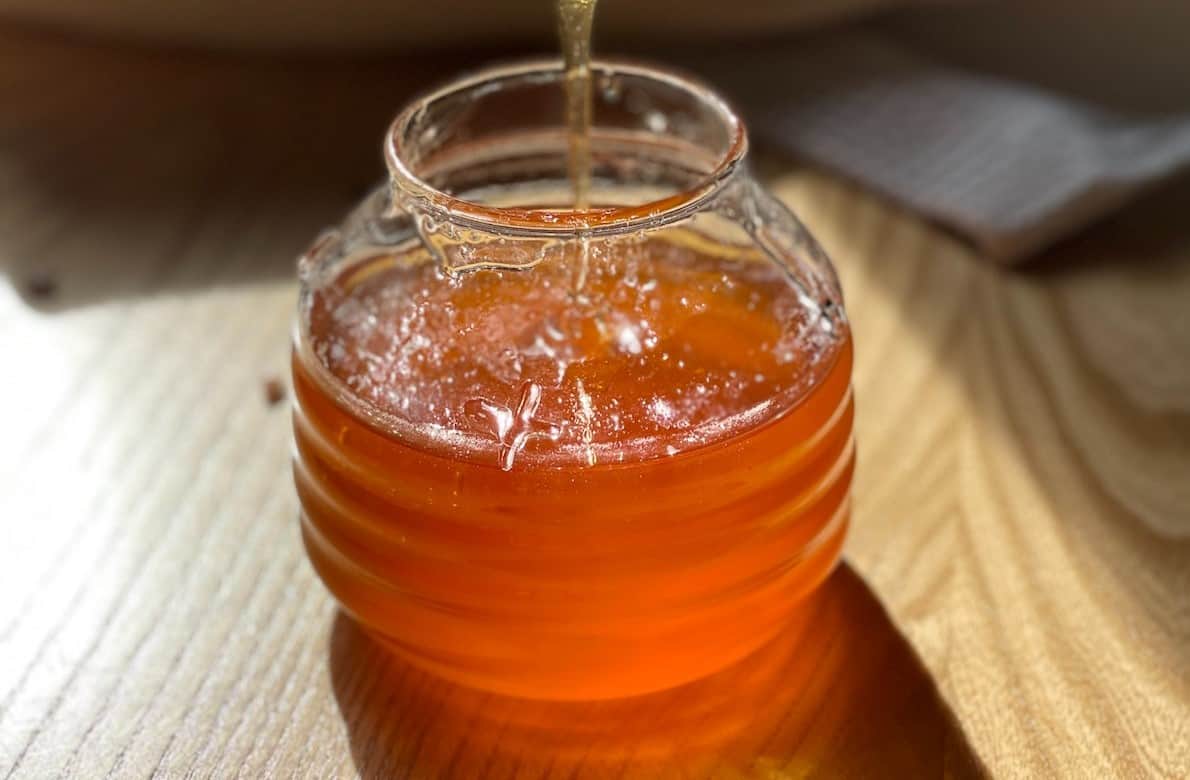

Good info. Keep it up
Love this article! Good amount of humor to give it a little extra oompf! Thank you very much! Could you recommend a great start up size? I’d like to buy once and not have to go back and buy more. What is the average size of a beehive I see many that are 3 boxes and some that are 5 and a few as many as 7. Thanks again!